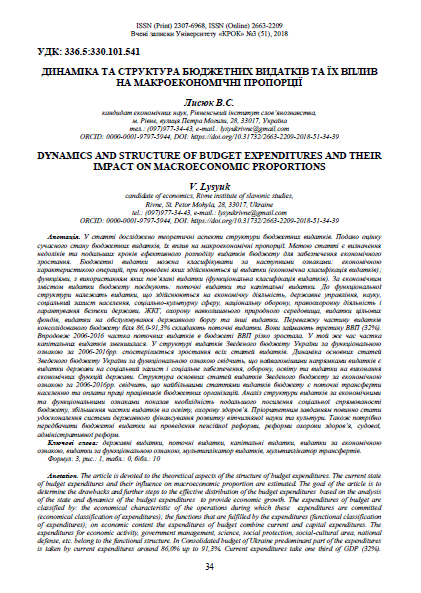DYNAMICS AND STRUCTURE OF BUDGET EXPENDITURES AND THEIR IMPACT ON MACROECONOMIC PROPORTIONS
DOI:
https://doi.org/10.31732/2663-2209-2018-51-34-39Keywords:
government expenditures, current expenditures, capital expenditures, expenditures on an economic basis, expenditure on a functional basis, expenditure multiplier, transfer multiplierAbstract
The article is devoted to the theoretical aspects of the structure of budget expenditures. The current state of budget expenditures and their influence on macroeconomic proportion are estimated. The goal of the article is to determine the drawbacks and further steps to the effective distribution of the budget expenditures based on the analysis of the state and dynamics of the budget expenditures to provide economic growth. The expenditures of budget are classified by: the economical characteristic of the operations during which these expenditures are committed (economical classification of expenditures); the functions that are fulfilled by the expenditures (functional classification of expenditures); on economic content the expenditures of budget combine current and capital expenditures. The expenditures for economic activity, government management, science, social protection, social-cultural area, national defense, etc. belong to the functional structure. In Consolidated budget of Ukraine predominant part of the expenditures is taken by current expenditures around 86,0% up to 91,3%. Current expenditures take one third of GDP (32%). During 2006-2016 the part of the current expenditures in the budget in GDP was rapidly increasing. In return the part of the capital expenditures decreased over the same period of time. In the expenditures structure of the Consolidated budget of Ukraine all expenditures clauses are increasing by the functional feature over the researched period of time. The analysis of the expenditures by the economical and functional features showed the necessity of the future reinforcement of the social budget orientation and increase of expenditures especially for education and health care. The improvement of governmental system of financing the domestic science and culture should be set as the priority. The budget expenditures for retirement, judicial and administration reforms should be foreseen too. The existing system of use and distribution of the capital expenditures has to be revised too.
Downloads
References
Алімпієв Є.В. Фінансово-монетарна трансмісія у державному регулюванні економіки: монографія. Кам’янець-Подільський, 2013. с. 117-118.
Василик О.Д., Павлюк К.В. Бюджетна система України: підручник. Київ : Центр навчальної літератури, 2004. с. 123.
Льовочкін С.В. Макроекономічна стабілізація в Україні у контексті економічного зростання: монографія. Київ, 2003. 432с.
Радіонова І.Ф. Макроекономіка: теорія та політика. підручник. Київ : Таксон, 2004. 165-166 с.
Лазебник Л.Л., Федосов В.М., Юхименко П.І. Теорія фінансів: підручник. Київ : Центр учбової літератури, 2010. с. 233-234.
Perotti R. In Search of the Transmission Mechanism of Fiscal Policy NBER Macroeconomics Annual. NBER, 2007. Vol. 22. 58p.–p.31. URL : http://www.nber.org/papers/w13143 (дата звернення 27.09.2018).
Офіційний сайт Міністерства фінансів України URL : http//www.minfin.gov.ua (дата звернення 27.09.2018).
Офіційний сайт ДКСУ URL : http//www.ukrstat.gov.ua (дата звернення 27.09.2018).
Башко В.Й. Ефект витіснення: аналіз причинно-наслідкових зв’язків/ Економічна теорія : журнал. 2008. с. 82-95.
Балдаччи З., Гупта С. Бюджетные экспансии: что действует? Структура налогово-бюджетной политики тесно связана с продолжительностью финансового кризиса. Финансы и развитие : журнал. 2009. №12.


